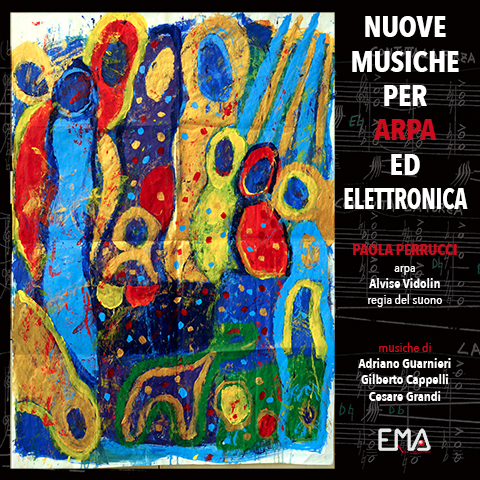Nuove musiche per arpa ed elettronica
musica di Adriano Guarnieri, Gilberto Cappelli, Augusto Cesare Grandi
Album monografico – artista principale: Paola Perrucci e Alvise Vidolin
Tracce
Adriano Guarnieri
i. Senti il crepitio di acque fragorose
per sette arpe e live electronics
frammento tratto dall’opera Pietra di Diaspro
Gilberto Cappelli
ii. Alba per arpa amplificata
Cesare Augusto Grandi
iii. Risonanze II per arpa ed elettronica
Gilberto Cappelli
iv. Un giardino per Annamaria
per arpa amplificata
Organico Arpa, Arpa con Elettronica
«Opere Originali per Arpa e Arpa con elettronica dedicate a Paola Perrucci»
Produzione Febbraio 2018 EMA Vinci service – Fibbiana, Monteluopo (Fi)
Data di Uscita 14.12.2018
Formato Principale CD Altri Formati Album digitale e 5.1
℗ 2018 EMA Vinci records 70138 © EMA Vinci – Etichetta EMA Vinci contemporanea
Linea SIAE Classici di Oggi • Genere – Contemporanea
Paola Perrucci Paola Perrucci and her Harp are constantly searching out both sonorous and virtuoso qualities, much of which as yet unexpressed, aimed at taking traditional technical possibilities towards new limits. Her specific attention to contemporary music has lead to an increasing number of composers taking a fresh interest in this new instrumental reality. Indeed, to date, a great deal of music has been written for and dedicated to her. In particular, we should mention musical productions such as “Solo di Donna” by Adriano Guarnieri and “Storia di Tawaddud” by Andrea Talmelli both of which arose from the ideas of Perrucci herself. These works, as with the forthcoming “Process a Costanza Monti”, by Guarnieri and Silvia Cecchi, revolve around women’s themes, in their transcendental and immanent forms. One other important feature of her instrumental research is that which concerns the re-examination ancient works, for example the reutilization of almost forgotten pieces like Bochsa and Labarre’s operatic paraphrases. Wholly original is her delivery of music for mechanical clocks by C. Ph. E. Bach, in which the similarity to the sounds of the harp is evident and historically tested.

